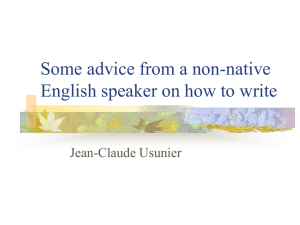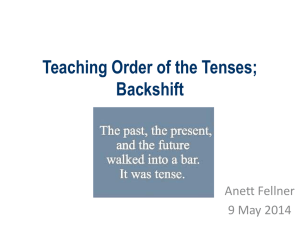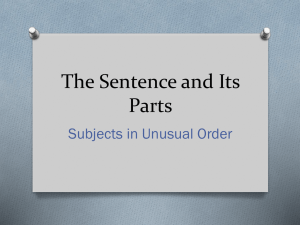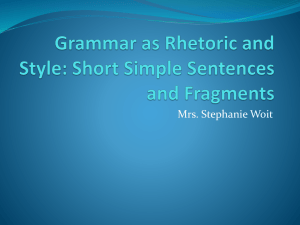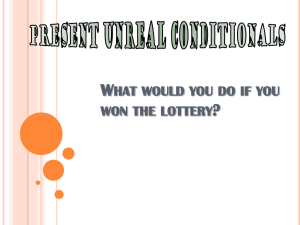Case Study 1
advertisement
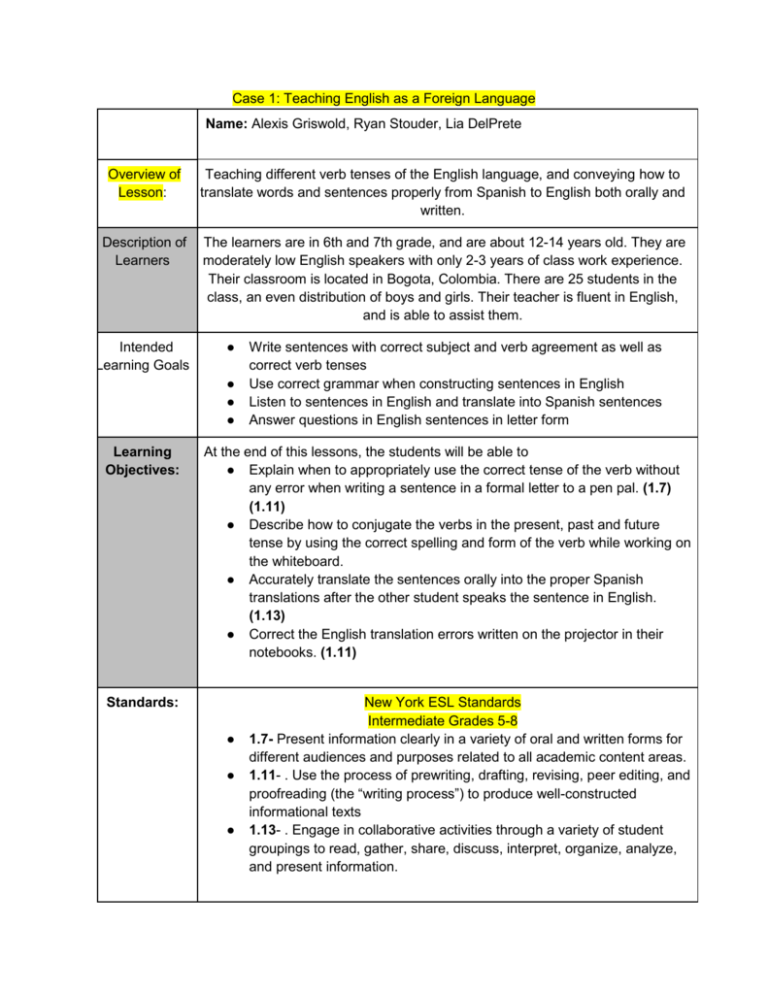
Case 1: Teaching English as a Foreign Language Name: Alexis Griswold, Ryan Stouder, Lia DelPrete Overview of Lesson: Teaching different verb tenses of the English language, and conveying how to translate words and sentences properly from Spanish to English both orally and written. Description of Learners The learners are in 6th and 7th grade, and are about 12-14 years old. They are moderately low English speakers with only 2-3 years of class work experience. Their classroom is located in Bogota, Colombia. There are 25 students in the class, an even distribution of boys and girls. Their teacher is fluent in English, and is able to assist them. Intended Learning Goals ● ● ● ● Write sentences with correct subject and verb agreement as well as correct verb tenses Use correct grammar when constructing sentences in English Listen to sentences in English and translate into Spanish sentences Answer questions in English sentences in letter form Learning Objectives: At the end of this lessons, the students will be able to ● Explain when to appropriately use the correct tense of the verb without any error when writing a sentence in a formal letter to a pen pal. (1.7) (1.11) ● Describe how to conjugate the verbs in the present, past and future tense by using the correct spelling and form of the verb while working on the whiteboard. ● Accurately translate the sentences orally into the proper Spanish translations after the other student speaks the sentence in English. (1.13) ● Correct the English translation errors written on the projector in their notebooks. (1.11) Standards: New York ESL Standards Intermediate Grades 5-8 1.7- Present information clearly in a variety of oral and written forms for different audiences and purposes related to all academic content areas. 1.11- . Use the process of prewriting, drafting, revising, peer editing, and proofreading (the “writing process”) to produce well-constructed informational texts 1.13- . Engage in collaborative activities through a variety of student groupings to read, gather, share, discuss, interpret, organize, analyze, and present information. ● ● ● Lesson Content Materials Procedures This lesson includes activities that encourage students to write and speak in English. The lesson allows students to translate from English to Spanish and correct English errors. They will gain knowledge on how to conjugate verbs, speak in English and practice translating. ● ● ● ● ● ● ● Paper Pencil Projector Whiteboard Dry-Erase markers English Composition Journal English error sentences 1. Begin by addressing the class on how to conjugate the verb endings of the present, past and future tenses. Have the students, by raising their hand, volunteer answers of which endings are for the given tenses. This material was presented in the previous lesson so students should already have the ideas and concepts, but will work on mastering these concepts in this current lesson. The endings should be written on the whiteboard to serve as a visual aid. Once all the endings for all the tenses have been collected, the lesson can proceed with learning activities. Allot five minutes or so to complete this task. 2. Write any regular verbs on the whiteboard, and have the students conjugate them into the past, present and future tenses using the appropriate verb endings. Each student should conjugate one tense of one given verb. The next student will conjugate the same verb in a different tense. There should be enough verbs so that every students gets a few chances to conjugate the verbs on the whiteboard. After this is completed, move on to the next activity. Allot 15 minutes to complete this activity. 3. Split the class into pairs. If possible, try and match students by their capabilities and fluency in English to better the learning experience for each student. The students will work with each other by speaking in English and translating in Spanish. Student one will create and speak a sentence in English to their partner. The partner will actively listen to the English sentence and then translate it back orally in Spanish. The student that created the English sentence should confirm that the translation is correct. Once the sentence is correctly translated, the students will switch roles and repeat the activity. Once the process has caught on, encourage the students to create sentences that go with the previous sentence to make the sentences more of a conversation. After a while, ask the pairings to present an example of an English sentence they created out loud to the class by speaking and translating the sentence. Call on pairs randomly to ensure that the activity was actually being performed. This whole process should last ten minutes in length. 4. The final activity will consist of correcting errored sentences from the projector into the students’ English Composition Notebook. Write sentences on the projector that have English errors within the sentence. Errors should include spelling, gramatical, conjugating and subject/verb agreement errors. Have the students copy the error sentence into their journal, and then rewrite the sentence without any error. Do numerous sentences so that students get practice with different kinds of errors. This should last about 12 minutes. 5. Now that the lesson has been taught, explain to the students what their assignment is. They are to write a letter to their pen pal using proper English; this includes proper verb tense, correct spelling and punctuation, and overall proper grammar. Topics that students should focus on in their letter are where the student is from, how old your student is, what their interest and hobbies are, and have them ask their pen pal a question about their life. This assignment needs to be written by hand, and after you grade it then they can rewrite it to send to their pen pal. Assessment 6. Students will compose a letter to their pen pal using proper English in their sentences.This letter should cover the topics of: where the student is from, how old your student is, what their interest and hobbies are, and have them ask their pen pal a question about their life. When grading look for accuracy in proper verb tense. Since we are reviewing verb tense in this lesson, this should be done without any error. Also, pay attention to subject verb agreement, proper punctuation, correct spelling, and overall correct grammar. Make sure that all topics listed above are covered in their letter. This assignment needs to be written by hand first, and after you grade it then they can rewrite it to send to their pen pal. References Journal Articles: Sherafat, Z., Vahdany, F., & Arjmandi, M. (2014). THE STUDY OF DIFFERENT LANGUAGE VIEWS PREVALENT IN TEACHING A SECOND LANGUAGE: EVIDENCE FROM IRANIAN EFL LEARNERS. Modern Journal Of Language Teaching Methods, 4(2), 227-236 Gholami, V., Moghaddam, M., & Attaran, A. (2014). TOWARDS AN INTERACTIVE EFL CLASS: USING ACTIVE LEARNING STRATEGIES. Modern Journal Of Language Teaching Methods, 4(2), 124-136. Standards derived from: http://www.p12.nysed.gov/biling/resource/ESL/04Inter.pdf Reference Materials (Annotations) (Sherafat) This article compares two main English concepts; language as a system and language as a discourse. The study had the goal of determining which method was used more frequently in the elementary grade levels. English classes were surveyed and out of those surveyed, 15 teachers were chosen to complete this study. Those teachers’ teaching methods were studied to determine which English concept was used more frequently in their classroom. The results displayed that language as a system was used more frequently in the classroom by teachers. (Gholami) This article focuses on active learning strategies and their benefits in creating a more interactive learning environment for the students. Language is being viewed as “interactive nature” and is being compared in English as a Foreign Language classrooms. The intent of this article is to help teachers create an active learning environment for their students through active learning strategies and guidelines for good practice. Weebly links http://grizz270.weebly.com/ http://Liadelprete.weebly.com/ http://ryanstouder.weebly.com/



